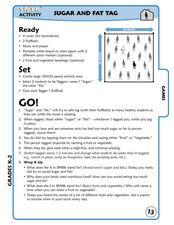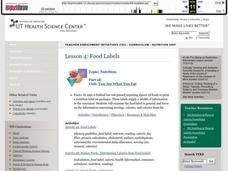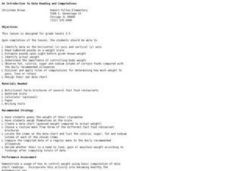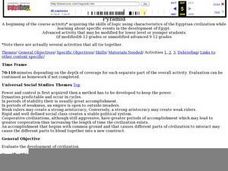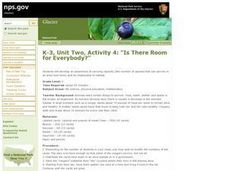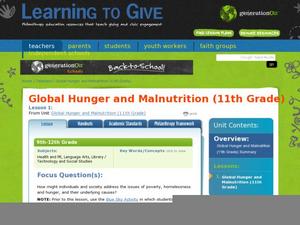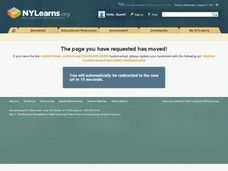Curated OER
Sugar and Fat Tag
Students participate in a game of chase and learn about healthy food choices. In this physical activity and healthy diet lesson, students play a game of chase by role playing as sugar and fat examples Students name examples of fruits and...
Curated OER
You Are What You Eat
Learners examine food labels and study serving size and calories. In this healthy eating lesson students complete several activities to understand food labels.
Curated OER
Breakfast Boosts Brainpower
Students examine the importance of eating a balanced breakfast. In this healthy eating lesson students identify examples of a healthy breakfast and compare the characteristics of people who do or do not eat breakfast.
Curated OER
An Introduction to Data Reading and Computations
Students discover data reading and computations. In this math lesson plan, students collect nutritional data about intakes of certain foods compared with daily recommended allowances. Students create their own data charts based on their...
Curated OER
California Strawberries
Young scholars study the nutrients of strawberries and compare them to other foods. In this strawberries lesson plan, students study the healthy strawberries and compare and contrast them to other foods that are not as healthy.
Curated OER
The Energy Equation
Students explore human energy components. In this personal health lesson plan, students determine how food, sleep, and exercise impact human energy levels as they play BAM! Body and Mind interactive games. Students create motivational...
Curated OER
Snacks
Learners study how healthy snacks are a better choice and the results of unhealthy snacking. In this healthy eating lesson students examine how to choose good healthy snacks.
Curated OER
Child Care Unit
In this activity, child care apprentices prepare granola bars to serve to preschoolers. A recipe and lab evaluation sheet are included, but the actual procedure is vague. It could be used in a cooking class or as a career exploration...
Curated OER
A Funky Healthy Life Style!
Learners name the five food groups and classify foods according to group. They tell how proteins, carbohydrates, vitamins/minerals, and water help their body. Students discuss how play and exercise can help their body.
Curated OER
Nutrition: Why do we need rice in our diet?
Second graders discover what the Food Guide Pyramid represents. In this health lesson, 2nd graders experience the types of foods represented in each of the groups found in the pyramid. As part of this lesson, students discover one food...
Curated OER
Family Life Cycle - Children's Lab
Students review how their nutritional needs change over time. In groups, they design their own menu in which they get all the nutrients they need. To end the lesson, they share their foods with the class and complete a wordsearch...
Curated OER
Pyramid
Students work in small groups as they are assigned one of the food groups. They decide how to act out one of the foods included in that group. Next, they discuss their favorite foods and where they fit on the food pyramid and examine the...
Curated OER
Is There Seaweed/Algae in Your Food?
Students discover that seaweed/algae is a small part of the resources the oceans provide. By investigating common household products, students discover that human senses are not enough to detect the presence of seaweed/algae in food.
Curated OER
"Mush Lab"
Students use the information they learned from reading food labels to create mush meals. They blend unlikely meals together to form the mush and then evaluate its nutritional value. They examine their own eating habits after the lab is...
Curated OER
Is There Room for Everybody?
Third graders examine the capacity of animals able to live in one habitat. In this habitat lesson, 3rd graders play a game that shows the food chain and the interactions between animals in an area. Students discover that food is a major...
National Endowment for the Humanities
“Read All About It”: Primary Source Reading in “Chronicling America”
Can investigative journalism become too sensationalistic and accusatory, or is it vital for the survival of a democracy? Middle schoolers analyze primary source documents from early 20th-century newspapers as well as Theodore Roosevelt's...
Curated OER
Ratios, Rates, Percent and Nutrition
Examine food labels to determine percentage of fat and sugar to total calories with middle schoolers. Daily nutritional guidelines are discussed and learners will decide how well their foods fit into a healthy diet. In the provided...
Curated OER
Global Hunger and Malnutrition
Is there a difference between hunger and malnutrtion? Is this a problem only in third world countries? How does hunger and malnutrition affect the community? Why do these problems exist when the world produces enough food to feed...
Curated OER
The Circulatory System--Part III
Students research the process for the preparation of a soup. Students explore the safety issues of food preparation. Students, after presenting their soups to the class, will eat their soups that they have prepared.
Curated OER
Home Living / Daily Living: Personal Hygiene—Use of Napkin
Staying clean is a big part of staying healthy and looking good in the community. Personal hygiene and napkin use are the focus of this activity. Your class will eat a messy food, look in a mirror to see if their face is messy, then...
Curated OER
Feelings and Emotions
Students discuss and write about different feelings they or someone else may have. In this feelings lesson plan, students discuss different ways they express their feelings. Then they get a picture with someone who is demonstrating a...
Curated OER
Planning to Parent, Day 1: Infant Health
What do infants need? What are parental responsibilities? Why breastfeed? What are the pros and cons? When do infants sit-up, roll over, crawl, talk, get teeth, eat solid foods, and sleep through the night? So many questions, and this is...
Curated OER
Stress Management
Stressed? Stressed students? Check out a instructional activity that includes a checklist of causes of stress, suggestions for ways to deal with stress, and a role-play activity. Definitely worth a look.
University of Wisconsin
Conjunction Function
As part of a unit, this lesson familiarizes youngsters with components of a rain garden. They speculate about the role of an assigned component in contributing to a rain garden, and ultimately, in the health of the local watershed. Each...


